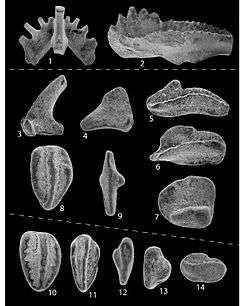Konodont
| Konodont |
| Bilimsel sınıflandırma |
|
|

Konodont elementleri
Konodontlar, yılan balığına benzeyen nesli tükenmiş kordalılardır.
Sınıflandırılması
Conodontlar, Kordalılar şubesinde sınıflandırılmaktadır çünkü yüzgeçlilerdir. Notokorda, Kordalıların özelliklerini taşımaktadırlar.[1]
| Craniata |
| ||||||||||||||||||||||||||||||||||||||||||||||||||||||||||||
| |
Ayrıca bakınız
- Aldridge, R. J.; Briggs, D. E. G.; Smith, M. P.; Clarkson, E. N. K.; Clark, N. D. L. (1993). "The anatomy of conodonts". Philosophical Transactions of the Royal Society of London, Series B 340: 405–421. DOI:10.1098/rstb.1993.0082.
- Aldridge, R. J.; Purnell, M. A. (1996). "The conodont controversies". Trends in Ecology and Evolution 11: 463–468. DOI:10.1016/0169-5347(96)10048-3. PMID 21237922.
- Donoghue, P. C. J.; Forey, P. L.; Aldridge, R. J. (2000). "Conodont affinity and chordate phylogeny". Biological Reviews 75 (2): 191–251. DOI:10.1017/S0006323199005472. PMID 10881388.
- Gould, Stephen Jay (1985). "Reducing Riddles". In The Flamingo's Smile, 245-260. New York, W.W. Norton and Company. ISBN 0-393-30375-6.
- Janvier, P (1997). "Euconodonta". The tree of life web project, http://tolweb.org. 24 Aralık 2015 tarihinde kaynağından arşivlendi. http://web.archive.org/web/20151224222113/http://tolweb.org/tree?group=Euconodonta&contgroup=Vertebrate.
- Sweet, Walter. The Conodonta.
- Sweet, W. C.; Donoghue, P. C. J. (2001). "Conodonts: past, present and future". Journal of Paleontology 75 (6): 1174–1184. DOI:10.1666/0022-3360(2001)075<1174:CPPF>2.0.CO;2. ISSN 0022-3360.
Dış bağlantılar
- Mark Purnell. "An oblique anterior view of a model of the apparatus of the Pennsylvanian conodont Idiognathodus". 12 Mayıs 2015 tarihinde kaynağından arşivlendi. http://web.archive.org/web/20150512004554/http://www.le.ac.uk:80/geology/map2/map2stuff/model.html.
- ""The Jaws That Catch": an Introduction to the Conodonta". Palæos. 20 Aralık 2010 tarihinde kaynağından arşivlendi. http://web.archive.org/web/20101220204814/http://palaeos.com/Vertebrates/Units/030Conodonta/030.000.html. Erişim tarihi: 2007-09-05.
- Jim Davison (2002-10-15). "Ordovician conodonts". 29 Eylül 2015 tarihinde kaynağından arşivlendi. http://web.archive.org/web/20150929085312/http://conodont.info/. Erişim tarihi: 2009-07-07.
Notlar
Kaynaklar
- ↑ Briggs, D. (May 1992). "Conodonts: a major extinct group added to the vertebrates". Bilim 256 (5061): 1285–1286. DOI:10.1126/science.1598571. PMID 1598571.
- 1 2 Sweet, W. C.; P. C. J Donoghue (2001). "Conodonts: past, present, future". Journal of Paleontology 75 (6): 1174–1184. DOI:10.1666/0022-3360(2001)075<1174:CPPF>2.0.CO;2.
- ↑ Bourlat, S. J; T. Juliusdottir, C. J Lowe, R. Freeman, J. Aronowicz, M. Kirschner, E. S Lander, M. Thorndyke, H. Nakano, A. B Kohn, others (2006). "Deuterostome phylogeny reveals monophyletic chordates and the new phylum Xenoturbellida". Nature 444 (7115): 85–88. DOI:10.1038/nature05241. ISSN 0028-0836. PMID 17051155.
- ↑ Here, the hagfish are treated as a separate clade, as in Sweet and Donoghue's 2001 tree produced without cladistic analysis.[2] However, it has been recognised by some [3] that the hagfish and lampreys may be closer to one another in their own clade, the Cyclostomata.
- ↑ The clade Proconodontida is also known as Cavidonti.
- ↑ Euconodonta is referred to as "Conodonti" by Sweet and Donoghue,[2] although this is not widely used.
This article is issued from Vikipedi - version of the 2/3/2016. The text is available under the Creative Commons Attribution/Share Alike but additional terms may apply for the media files.